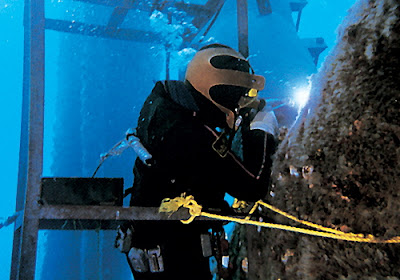The following article from The New York Times talks about the Leptoseris troglodyta, an unusual coral.
Over a decade ago, the coral researcher
Bert Hoeksema
found himself crossing from sunlit waters into an underwater cave in
the Philippines. It was “like a big hole in a steep wall,” he said.
 |
Leptoseris troglodyta, a coral found on the ceilings
of caves near tropical reefs in the Indo-Pacific region. |
Wielding a camera and a diving light in the darkness, he looked up
and saw strange clusters of white, delicate fungi-shaped polyps, like
the ghosts of corals, carpeting the ceiling.
Most scientists associate that white hue with coral death, but this species was very much alive — and heretofore undiscovered.
“By being active in the field, we bump into new species by accident,” Dr. Hoeksema, a researcher with the
Naturalis Biodiversity Center at the University of Leiden in the Netherlands, said in an interview. “It’s very thrilling.”
Twelve years later,
his study
of the albino coral has been published in the journal ZooKeys. The
species, Leptoseris troglodyta (in Greek, troglodyta means “one who
dwells in holes”), is known for inhabiting waters up to 35 meters (115
feet) deep, where the sunlight may be weaker and the ocean cooler, Dr.
Hoeksema said.
What sets the species apart from other corals is the absence of
zooxanthellae,
a photosynthesizing algae that delivers nutrients. Such algae are also
responsible for the bold swaths of color that characterize stony corals.
“The idea of white corals is not unknown at all,” Dr. Hoeksema said, referring to the
bleaching events
that increasingly cripple reefs. Decimated by waters that are
uncomfortably warm, algae frequently undergo a mass exodus that drives
the bleaching phenomenon.
Yet the whiteness of the new species is an anomaly, Dr. Hoeksema said, because it occurs naturally.
The lack of nurturing algae has left him flummoxed about how the
species feeds. “Their only option is to catch food with their tentacles —
they are very small, so I have no idea how they do that,” he said.
Dr. Hoeksema said that circulating particles of food cannot exactly
drop onto a ceiling, which makes it harder for stationary creatures to
gather nutrients. He speculates that some plankton bump into the corals.
This inefficient method of feeding could account for the coral’s
diminutive size – which in turn probably explains how it can colonize
ceiling spaces where other, larger cave creatures cannot fit.
Since his discovery in 1999, Dr. Hoeksema has found the pale polyps
on the ceilings of other Indo-Pacific caves and has established that
Leptoseris troglodyta dwells across a region that overlies parts of the
Coral Triangle,
a mecca for marine researchers. It is host to over 70 percent of the
world’s coral species and includes the waters of Indonesia, Malaysia,
the Philippines, Papua New Guinea, Timor Leste and the Solomon Islands.
With that level of coral density, it is perhaps unsurprising that new
species are periodically found. “We keep finding new species by going
to remote areas or remote habitats that are not investigated,” Dr.
Hoeksema said, noting that he recently discovered another coral in New
Caledonia.
His goal is mapping biodiversity. After all, he said, you have to be
familiar with the vast array of corals to recognize the paler, seemingly
insignificant ones like Leptoseris troglodyta as something exciting and
new.
One might think that the cave-dwelling coral’s ability to survive
without algae and sunlight offers some hope for the future of coral
reefs on a warming planet. But without photosynthesis and zooxanthellae,
corals will not grow quickly or gain significant mass, Dr. Hoeksema
said.
The discovery is valuable from a different standpoint, he said — the
development of undersea life. “This is an evolutionary novelty,” he
said.








